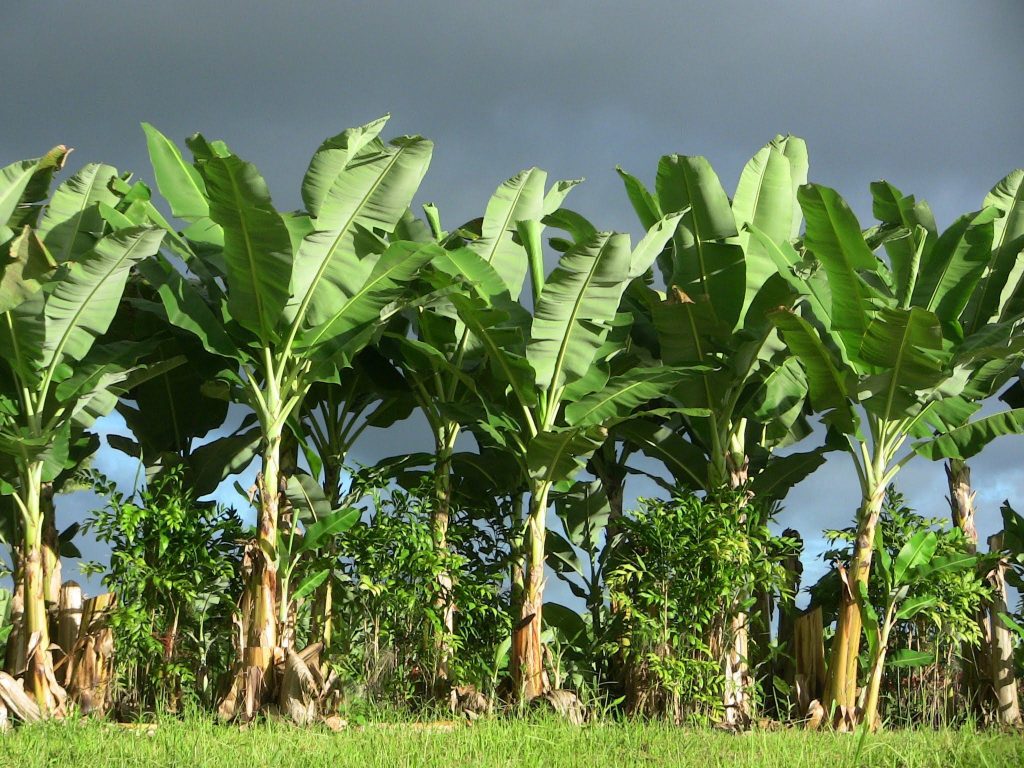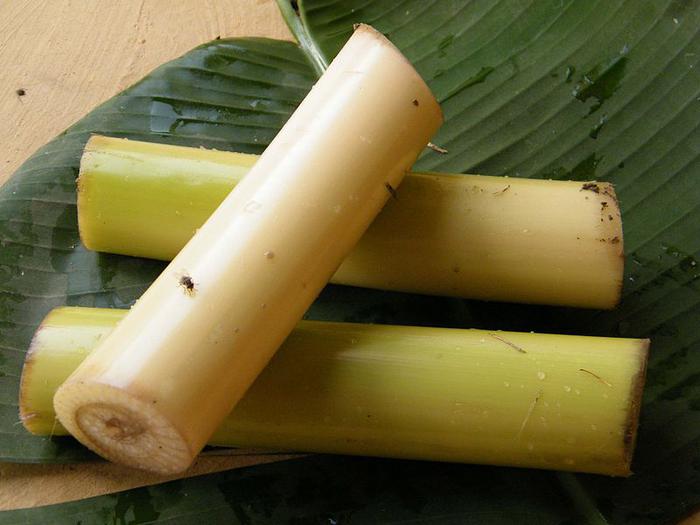Banana stems differ from other plant stems in that they originate from the flower stalk of the banana plant. Bananas have long been touted as healthy food, and we’ve believed it since we were children. Vitamins, minerals, and macronutrients are abundant in this food. The fruit, leaf, and banana stem all contain various nutrients that are beneficial to human health. Almost every part of the banana tree can also be used for commercial purposes.
The fruit of the banana tree is a member of the Musaceae family, specifically the species Musa. The fruit of the Australimusa sub-section of the Musa genus’ Fe’i banana is the primary reason for its cultivation. The Fe’i bananas have straight bunches, pink-red to purple sap, and yellow or orange fruit pulp. Herbs like banana and plantain can reach heights of up to 20 feet.
About the Bananas

India is the world’s most significant banana producer, producing an annual output of 14.2 million metric tons on average. In addition to Ecuador and the Philippines, the primary banana producers are Brazil, Mexico, China, and Costa Rica. Sometimes, people use the fruit and leaves, stem (also known as a ‘false stem’), flowers, and the roots of the banana tree as medicines. Bananas in North America are almost exclusively of a single variety. There are, however, a wide variety of bananas to choose from.
Bananas are nutritious fruit that can be used in a variety of ways for their medicinal benefits. Hypokalemia, constipation, and diarrhea are just a few conditions it can help alleviate. Bananas are also commonly used to treat diabetes, high cholesterol, and many other health issues, but none of these claims are backed by solid scientific evidence.
Chemicals and carbs abound in bananas. Some of these carbohydrates are fibers, which serve an essential function in regulating the gastrointestinal tract. In addition, antioxidants, such as those found in these substances help reduce swelling and fight free radicals. Potassium, vitamins, and other nutrients are also found in bananas.
Nutritional Contents in Banana Stem
- Iron (Fe)
- Manganese (Mn)
- Carbohydrates
- Fibers
- Other minerals & micronutrients
- Potassium (K)
- Vitamin B6
- Vitamin C
- Magnesium (Mg)
- Copper (CU)
What You Need to Know About Banana Stems

Banana stems differ from other plant stems in that they originate from the flower stalk of the banana plant. The plant’s spine is formed by the thick stalks that grow from the ground. When eaten raw, the banana stem has a mild flavor and a crispy exterior. In contrast, it’s sweet with a harsh aftertaste, so beware. Because of this, the stalk might be considered the banana plant’s stem.
A banana stalk can harvest only one gigantic bloom cluster before it dies. The stem is usually removed from the plant when the bananas are fully ripe. As a result, the banana stem is a popular food item.
The Health Benefits of Banana Stem
As a result of its high fiber content, the stem of a banana has long been used to treat constipation and ulcers. Vitamin B6 and potassium are also abundant in banana stems. As a result, those with anemia or diabetes should consume this cuisine regularly, according to the experts. Additionally, the banana stems have the following advantages:
Protects the Kidneys from Damage
Patients with gall bladder stones are commonly advised to eat banana stems as part of their diets by doctors. As a beverage or as part of a meal, you can incorporate banana stem into your diet.
As a diuretic, stem juice is a good choice for removing kidney stones. The bladder is soothed and cystitis is alleviated when this juice is combined with cardamom. Infection of the urinary tract (UTI) known as cystitis affects the bladder. It affects more women than men. Cystitis is usually self-healing. However, in the most severe cases, antibiotics would be necessary.
Impedes Hypertension
When the blood pressure against the walls of the arteries is too high, it is called hypertension or high blood pressure. Hypertension increases the risk of a stroke if it is not treated. According to the Centers for Disease Control and Prevention (CDC), nearly half of the adult population in the United States has hypertension.
Potassium, found in abundance in banana stems, is well-known for its ability to stabilize blood pressure. It is therefore possible to minimize the risk of cardiovascular disease by eating banana stems on a daily basis.
Detoxification
Banana stem juice is a powerful diuretic, helping to remove waste products from the body. It’s also popular as a beverage because of this. It’s a diuretic that also has digestive system-friendly effects. Additionally, it is rich in fiber, which is essential for a healthy digestive tract.
The acidity levels in the body are regulated and balanced by banana stem juice. As a result, heartburn and other digestive system problems are lessened.
Prevention of Diabetes
In low and middle-income nations, the prevalence of diabetes is increasing at a faster rate than in high-income ones. According to the World Health Organization (WHO), obesity, sedentary and unhealthy lifestyles, and genetic history are all contributing factors to an increasing number of diabetes cases globally.
Vitamin B6 serves as a cofactor in several processes that affect a variety of bodily functions. As a result, numerous diseases, including Parkinson’s, diabetes, autism, and cancer, can be exacerbated or even caused by a lack of it.
Risks and effectiveness have been linked in studies involving vitamin B6 with diabetes. Vitamin B6 deficiency may cause diabetes in Drosophila, according to research. In this regard, banana stems, which are a good source of vitamin B6, are thought to be beneficial in the fight against diabetes. In addition, the stem’s vitamin B6 aids in hemoglobin and insulin production.
The stem can also be used to treat hyperglycemia. By stimulating insulin-like enzymes, the lectin in the banana stem helps control fat cell growth. Furthermore, banana stems are ideal for diabetics because they have a low glycemic index.
Maintain a healthy weight
Banana stem juice has been shown to be quite effective in the fight against obesity. Because of the high fiber content, eating less and losing weight is easier because hunger and cravings are lessened and fewer calories are consumed. In addition, fiber aids in the absorption of sugars and fats by cells in the body. The raw stem parts, if eaten as a salad, assist prevent obesity by reducing fat intake.
Sustains a healthy blood count
According to the World Health Organization (WHO), in 2019, the global prevalence of anemia among women aged 15-49 years was 29.9 percent. According to the National Center for Health Statistics, 39.8% of children aged 6 to 59 months were anemic.
Medical practitioners highly advocate banana stems for the treatment of anemia. They are high in iron and vitamin B6, both of which are known to help increase the amount of hemoglobin in the bloodstream.
Constipation is alleviated
Constipation can be relieved by eating the plantain stem, which is high in fiber. Because of this, juice consumption for the treatment of constipation is really beneficial. The juice should not be strained to preserve the drink’s fiber content, according to experts.
Prevents the production of LDL Cholesterol
Approximately one-third of all ischemic heart disease cases worldwide are caused by excessive cholesterol levels, according to WHO reports. More than 2.6 million people die each year as a result of excessive cholesterol. About 13% of American adults had cholesterol levels over 240 mg/dL between 2015 and 2018, according to the CDC.
The stem of a banana can also be used to effectively regulate cholesterol levels. Iron and vitamin B6 are abundant in them, and these nutrients are critical in raising hemoglobin levels and lowering bad cholesterol (LDL).
Stops Infection of the Urinary Tract
UTI is one of the most frequent infections that affect women worldwide, according to research. As a result of a urinary tract infection (UTI), women are more likely to develop vaginal infections.
The diuretic qualities of banana stem juice are well known. Consequently, it helps drain out impurities and cleanse the urinary tract. As a result, the easiest way to avoid urinary tract infections is to drink banana stem juice three times a week.
The Ayurveda of Banana Stem
According to Ayurveda, the banana tree and all of its parts have tremendous therapeutic value for treating a wide range of ailments. Synonyms such as Kadali, Vaarnaa, Mocha, Ambusara, and Anshumatiphala are all used to describe it. Bananas have numerous Ayurvedic applications, including the following:
- Vata problems and thirst can be alleviated by drinking the stem of a banana. Energy and movement processes are controlled by Vata, which governs everything from eyelid blinking to muscle movement. Improves circulation, breathing, and the nervous system functioning, among other things.
- Banana stem juice is an effective diuretic for removing kidney stones.
- Coughs can be soothed with banana stem sherbet (syrup).
- The inner sensitive stem can be eaten as a vegetable.
Harmful Effects of Banana Stem
Although banana stem has no serious negative effects, some of the probable side effects include allergies, stomach aches, vomiting, or injury to the liver and kidneys. However, a person’s medical history and the quantity of banana stem they take are both factors to consider. When it comes to food and drink, moderation is key. An allergic reaction to the skin is another possibility.
A doctor, medical expert, nutritionist, or dietician should always be consulted in such cases. Ignoring the above-mentioned signs can have serious consequences for your health.
The Best Methods for Eating a Banana Stem

It takes time to clean and cut the banana stem, therefore many people avoid it. Although it is beneficial in many ways, there are simple strategies to avoid wasting time. They keep well in the fridge for days after cleaning and cutting if soaked in buttermilk. You can then utilize it to produce juice for consumption, depending on your needs. Buttermilk, on the other hand, should be swapped out over time.
A finely chopped banana stem is a common ingredient in sweet and sour vegetable soups and curries in Southern Thailand. As a result, you can incorporate banana stems into your food.
- Before peeling the outer layers, make sure the surface is clean.
- Slice the banana stem into small pieces in the next step.
- It’s up to the individual to decide if they prefer it fried or uncooked.
- Cutlets, kebabs, and tikkas are all tasty ways to prepare fibrous foodstuff.
Banana stems are fried in West Bengal and used in meals. People in South India utilize banana stems in a variety of cuisines because the region is tropical. Vazhaithandu Pachadi, a type of raita cooked using banana stems, is a popular dish. It’s easy to make, and it’s especially good for your health during the warm months.
Frequently Asked Questions (FAQs)
Q. How beneficial is banana stem juice for kidney stones?
Currently, doctors often recommend that patients with gallbladder stones include banana stems in their diet. The stem of a banana should be consumed at least once a week, either as a beverage or as a meal. Small kidney stones can be alleviated by drinking stem juice, which is a good diuretic.
Q. When to drink banana stem juice?
One of the most important things you can do for your health is to sip on a glass of banana stem juice in the morning three times a week. The individual’s needs, issues, and medical history all play a role in whether or not this is appropriate. To avoid possible side effects, it is best to consult a doctor.
Q. What part of the banana plant develops into a fruit?
It’s through a process called flower development that the banana fruit begins to take shape. The flower’s development takes place deep within the stem of the plant, which is hidden beneath the bases of the leaves. After cutting the banana plant, you won’t be able to see the first stages of flower development. Because of this, the stem does not appear above the leaves until the flower has finished growing.
Q. Is banana stem good for diabetes?
Hb and insulin production is aided by vitamin B6 in the stem. That’s why it’s good for your blood sugar levels to eat the stem. Furthermore, the lectin found in the banana stem stimulates insulin-like enzymes, which control the growth of fatty cells in the human body. Thus, the consumption of banana stems is regarded as an effective method of preventing diabetes.
Q. Can banana stems be eaten raw?
The fresh stems can be eaten raw. The stem, on the other hand, loses some of its tenderness after a day or two. To eat it, you’ll need to cook or fry it.
Q. How do you store banana stems long-term?
After cleaning and cutting, you can store them in the refrigerator for days by soaking them in buttermilk. After that, you can put it to whatever purpose you see fit. Among other things, you could use it to make juice for your own consumption. The sourness of the buttermilk should be taken into consideration when making a recipe.
Q. How do you remove fiber from banana stems?
The hard inner layer of the banana stem is edible, but you must remove and discard the porous outer layer. Banana fiber extraction is a straightforward process. The banana stem’s outer skin should be peeled off first. The next step is to flatten the inner layers and remove the fibers, either by hand or with commercial machines.
Q. Why are banana stems wrapped in plastic?
Banana stems can be kept fresh for a long time by wrapping them in plastic wrap. You should do this to prevent the stems from releasing ethylene gas.
Q. What makes bananas turn brown so fast?
The acids in bananas are broken down when they come into contact with ethylene gas. The green chlorophyll pigments in the fruit begin to break down as it softens. In the end, it turns a yellowish-brown color.
Q. Which part of the banana stem is edible?
A banana stem’s edible portion is the fibrous stalk’s interior. There are some steps you must take, however, to reveal the white or yellowish-green core of the plant.
The Bottom Line
Unlike the banana leaves, the banana stem is not made of wood. It’s known by a variety of names throughout India and around the world. Banana stems have long been known to be rich in flavor and nutrients. This plant component is very beloved in India. When it comes to food, it can be used in a variety of ways in different parts of the world. For its cost, medical benefits, and ease of use, it has found a place in every family. Food tolerance and capacity vary greatly from person to person. As a result, it is imperative to seek the advice of a medical professional if you notice any possible negative effects following ingestion.




